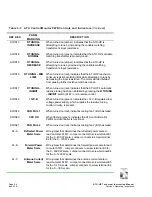
ATU-HP Technical Instruction Manual
Page 6-1
Section 6 Theory of Operation
Issue 2.0
ATU-HP
TECHNICAL INSTRUCTION MANUAL
Section 6
THEORY OF OPERATION
6.1 INTRODUCTION
The theory of operation for the ATU-HP is
presented in this section. Paragraph 6.2
provides overviews of the ATU-HP and its
functional blocks. More detailed theory is
provided in paragraph 6.3. Refer to Figure
6-1 for a block diagram of the ATU-HP.
6.2 ANTENNA TUNING UNIT
OVERVIEW
The ATU is an integral part of a radio beacon
(NDB) or DGPS transmitter system operating
in the LF/MF band (190 kHz to 550 kHz). It
interfaces an NDB or DGPS transmitter, such
as the Nautel Vector, to an antenna and
maintains the antenna impedance, as seen
by the transmitter, at 50 ohms under
changing environmental conditions (for both
resistance changes and antenna capacitance
changes). The ATU-HP provides a remote
antenna current sample to allow automatic
adjustment of the transmitter output power to
maintain a constant antenna current when
used with a Nautel Vector series transmitter.
Two base-mounted fans circulate the internal
air stream when the temperature exceeds
60°C. Provision is made to manually tune the
tuning unit locally and remotely from the
transmitter location.
6.2.1 ATU Control PWB
The ATU control PWB contains most of the
circuitry of the ATU-HP. It contains a servo
probe, forward/reflected power probe,
current probe, tuning drive circuitry (for the
resistive and inductive term), power
supplies, fan control, local controls, analog
power/antenna current meter, alarm and
status LEDs and microcontroller control.
6.2.1.1 Power Supplies
The ac power is rectified and filtered. This
unregulated supply is used to power the fans,
as well as generate the +12 V-A and +12 V-B
dc supplies for the motor drive circuitry. The
+12 V supplies are ORed together and
regulated to +5 V dc which is used to power
the microcontroller and other control circuitry
on the control PWB.
6.2.1.2 Servo Probe
The servo probe monitors the RF input for
voltage and current phase relationship. When
the load impedance is resistive, the voltage
and current are in phase and the servo probe
will not produce an output. When the load
impedance is inductive or capacitive, the
voltage and current will not be in phase. The
servo probe will then produce an
increase L
signal if more inductance is required or a
decrease L
signal if less inductance is
required. The information from the servo
probe signals is fed to the microcontroller
which controls the inductive motor.
6.2.1.3 Forward/Reflected Power Probe
The forward/reflected power probe samples
the RF signal and produces outputs that are
representative of the forward power and the
reflected power. These outputs, as selected
by
FWD/REFLD
switch A1S10, can be
displayed on the appropriate scale of meter
A1M1.
















































